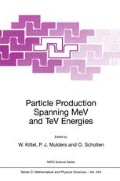Abstract
With the advent of the basic theory of strong interactions, quantum chromodynamics (QCD), has come the conviction that nucleons - and more generally, all strongly interacting elementary particles (hadrons) - are bound states of quarks. Quarks are point-like and confined to “their” hadron by a binding potential V o(r) which increases linearly with quark separation r,
where the string tension δ measures the energy per unit separation distance. Hence an infinite amount of energy would be needed to isolate a quark; it cannot exist by itself, and it is therefore not possible to split an isolated hadron into its quark constituents.
Access this chapter
Tax calculation will be finalised at checkout
Purchases are for personal use only
Preview
Unable to display preview. Download preview PDF.
References
N.F. Mott, Proc. Phys. Soc. (London) A62 (1949) 416.
V.V. Dixit, Mod. Phys. Lett. A5 (1990) 227.
H.Satz, Nucl. Phys. A418 (1984) 447c.
D. Bailin and A. Love, Phys. Rep. 107 (1984) 325; for a recent survey, see F. Karsch and M.P. Lombardo (Eds.), QCD at Finite Baryon Density, Nucl. Phys. A642 (1998).
M. Asakawa and T. Hatsuda, Nucl. Phys. A610 (1996) 470c.
K.G. Wilson, Phys. Rev. D10 (1974) 2445.
M. Creutz, Phys. Rev. D21 (1980) 2308.
F. Karsch and E. Laermann, Rep. Prog. Phys. 56 (1993) 1347.
L.D. McLerran and B. Svetitsky, Phys. Lett. 98B (1981) 195 and Phys. Rev. D24 (1981) 450.
J. Kuti, J. Polónyi and K. Szlachányi, Phys. Lett. 98B (1981) 199.
F. Karsch and E. Laermann, Phys. Rev. D50 (1994) 6954.
T. Blum et al., Phys. Rev. D51 (1995) 5153.
J. Engels et al., Z. Phys. C42 (1989) 341.
V. Goloviznin and H. Satz, Z. Phys. C57 (1993) 671.
F. Karsch, A. Patkos and P. Petreczky, Phys. Lett. B401 (1997) 69.
B. Svetitsky and L.G. Yaffe, Nucl. Phys. B210 [F561 (1982) 423.
P. Hasenfratz, F. Karsch and I.O. Stamatescu, Phys. Rev. 133B (1983) 221.
R.V. Gavai, A. Goksch and M. Ogilvie, Phys. Rev. Lett. 56 (1986) 815.
M. Ogilvie, Phys. Lett. B231 (1989) 161.
H. Satz, Nucl. Phys. A642 (1998) 130c.
G. Baym, Physica 96A (1979) 131.
T. Çelik, F. Karsch and H. Satz, Phys. Lett. 97B (1980) 128.
For a recent survey, see D. Stauffer and A. Aharony, Introduction to Percolation Theory, Taylor & Francis, London 1994.
U. Alon, A. Drory and I. Balberg, Phys. Rev. A42 (1990) 4634.
Alvarez, Phys. Rev. D24 (1981) 440.
For recent precision studies, see G. Bali, K. Schilling and C. Schlichter, Phys. Rev. 51 (1995) 5165 and Nucl. Phys. B (Proc. Supp.) 42 (1995) 273.
E.J. Garboczi et al., Phys. Rev. E52 (1995) 819.
H. Satz, hep-ph/9908339;
S. Fortunato and H. Satz, hep-lat/9908033
S. Fortunato and H. Satz, in preparation;
Author information
Authors and Affiliations
Editor information
Editors and Affiliations
Rights and permissions
Copyright information
© 2000 Springer Science+Business Media Dordrecht
About this chapter
Cite this chapter
Satz, H. (2000). The Quark-Gluon Plasma. In: Kittel, W., Mulders, P.J., Scholten, O. (eds) Particle Production Spanning MeV and TeV Energies. NATO Science Series, vol 554. Springer, Dordrecht. https://doi.org/10.1007/978-94-011-4126-0_3
Download citation
DOI: https://doi.org/10.1007/978-94-011-4126-0_3
Publisher Name: Springer, Dordrecht
Print ISBN: 978-0-7923-6432-0
Online ISBN: 978-94-011-4126-0
eBook Packages: Springer Book Archive

